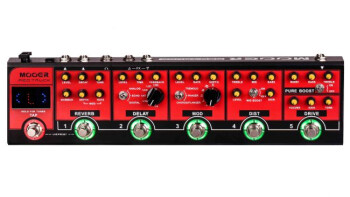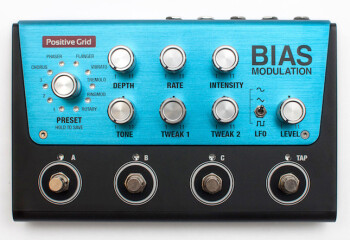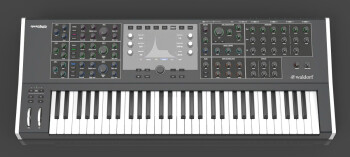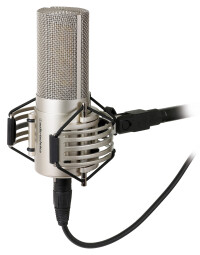The Musikmesse 2017 in Frankfurt ended last week and it was a good occasion for the Audiofanzine team to try out new gear.
We must admit that the tradeshow itself was a bit disappointing, not unlike last year… Is the once mighty giant in its death throes? Will it give way to something more specialized? Maybe Berlin’s Superbooth which has just begun, hosting the synth and computer music markets, is a response to that…
Until we find out, here are our own personal highlights of the Musikmesse 2017:
General Music Promega 2+
General Music introduced in Frankfurt the latest rendition of the Promega digital keyboard. You guessed it, it’s called Promega 2+. The audio engine combines sampling and modeling to handle string resonances, damping and even release. According to the manufacturer, the 88 keys are weighted, it has 160 note polyphony, 45 sounds and 128 presets (including 64 user presets). In terms of effects, it features 15 types of reverb, 15 programmable processing options and a 4-band graphic EQ.
Dexibell Combo J7 and Classico L3
Dexibell introduced several products, including the brand’s first digital organ – the Classico L3. Among its main features are 5 organ sounds (American Classic, French Symphonic, English Romantic, German Baroque, and Positive), 80 stops, 6 pedal sounds, and 13 solo sounds with legato. Plus, it includes 4 types of reverb and 3 types of “tremulants.” The Italian brand also introduced the J7 combo with 9 motorized drawbars, providing vintage solid-state and tone-wheel organ sounds. It features 24 types of reverb, 36 internal presets, 90 different sounds, a Leslie cabinet, an overdrive, and a vibrato/chorus.
Mooer Red Truck
Chinese manufacturer Mooer has been incessantly growing these past years and the Red Truck is the best proof of that. The brand made a name for itself with its compact pedals, but nowadays the brand seems intent on paving its way among the big shots in the market with much more complex products.
Take the Red Truck for instance, which resembles Tech21 gear a lot. It has 6 analog and digital effects sections with plenty of parameters, a Tap Tempo which can be assigned to the delays or modulations, and even a tuner.
But it does differentiate itself from competing products by offering stereo outputs, a Preset mode that allows you to record the activation of certain sections, and even an effects switcher. All of that for only $250, which makes it a serious concern for all similar gear if it can really deliver on its promises. Cross your fingers!
Salvi Delta
Who hasn’t dreamed of playing harp? Okay, that was a long shot, I know. Nevertheless, if you are into harps, Salvi’s Delta electric harp might help you get into the cool group.
It is carried around the neck and can be used with effects pedals (I can’t wait to try it with a Big Muff)! You could say it’s like a guitar but with way more strings! Isn’t that the dream of any guitar player? Metalheads out there: forget about those 8-strings, the time of the Delta Salvi has arrived!
Positive Grid Bias Modulation
The transition from software to hardware is still going on at Positive Grid. After the Bias Distortion and Bias Delay, the manufacturer has once again packed its modeling technology into a standalone pedal.
This is great news for all tube and solid-state amp lovers who had been waiting for the chance to have the Bias sound without the need of a computer. It features nine modulations and two banks of 10 presets each so you can record your own creations. Besides the 9 knobs available, the pedal combines seamlessly with the Bias Pedal software, which allows you to adjust it in a much more powerful way, and even to add effects.
The only thing we regret is that it isn’t particularly cheap ($399) and that Positive Grid seems somewhat conservative n their approach and doesn’t take too much risks.
Clavia Nord Stage 3
The introduction of the Nord Stage 3 is surely one of the biggest highlights of this Musikmesse. The famous Clavia stage keyboard is back on steroids! Among the many improvements are the memory, and the doubling of the polyphony for the piano but also the integration of the Nord Lead A1 synthesis engine with sample playback, the Nord C2D organ engine, and a Leslie emulation. Add to that the advanced split functions and a new Super Wave category in the synth section and it’s easy to realize we are looking at a future best-seller.
Waldorf Quantum
The biggest surprise at this year’s Musikmesse was this new monster by Waldorf. Based on three oscillators, it combines four types of synthesis (wavetable, analog modeling, granular, and resonator) with two dual analog filters, and is a direct descendant of the manufacturer’s long line of instruments and apps: MicroWave, XT, Q, Blofeld, Nave, etc. Its touchscreen allows you to adjust everything directly on the display and it features two layers of multi-timbrality. Who could resist it?
Zynaptiq Wormhole
Announced during the Musikmesse 2016 but introduced this year, the Wormhole combines different algorithms by the manufacturer (pitch shifting, warp, spectral inversion, reverb) to offer truly original processing options, ranging from vocal deformation to a sort of ring modulation. In short, yet another UFO hailing from Zynaptiq’s headquarters.
Audio-technica AT5047
When it comes to microphone, it was Japanese manufacturer Audio-Technica who took center stage with the AT5047, a new member of the 50 series. It takes after the AT5040, which means it features four rectangular diaphragms, but the output transformer was modified to achieve a smoother result. It can handle high SPLs so you can use it on brass instruments or the snare. At 4000 euros it’s certainly not cheap at all, but the manufacturer justifies the price tag arguing it is 100% handmade.
Line 6 Helix LT
The original Helix is without a doubt one of the most exciting pieces of gear in the guitar world right now. The fully digital pedalboard includes tons of amp, effects and cab emulations coupled with an unmatched ergonomic design. The only drawback is that you need to fork out $1500 to get your hands on it.
Hence, the introduction of a more accessible version in the form of the Helix LT is certainly a matter of rejoice! Even more so considering that they are exactly the same under the hood and, thus, provide the same sounds. The LT does lack some features in comparison though, like the small screens above the footswitches, as well as several inputs and outputs. And it is indeed less sexy, aesthetically speaking…but it comes with a $500 discount. A future hit?






